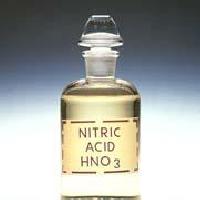

Nitric acid has an acid dissociation constant (pK a) of −1.4: in aqueous solution, it almost completely (93% at 0.1 M) ionizes into the nitrate ion NO 3 − and a hydrated proton, known as a hydronium ion, H 3O +. For this reason, heavy corrosion can be expected and should be guarded against by the appropriate use of corrosion resistant metals or alloys. Due to its oxidizing nature, nitric acid does not (with some exceptions) liberate hydrogen on reaction with metals and the resulting salts are usually in the higher oxidized state. Nitric acid is a strong acid that ionises almost completely in water, and a powerful oxidizing agent that also nitrates many organic compounds and a monoprotic acid because there is only one dissociation.īeing a typical acid, nitric acid reacts with alkalis, basic oxides, and carbonates to form salts, including ammonium nitrate. Nitric acid is subject to thermal or light decomposition with increasing concentration and this may give rise to some non-negligible variations in the vapour pressure above the liquid because the nitrogen oxides produced dissolve partly or completely in the acid. These mainly include the vapor pressure above the liquid and the boiling temperature, as well as the color mentioned above. Nitrogen oxides (NO x) are soluble in nitric acid and this property influences more or less, all the physical characteristics depending on the concentration of the oxides.

Two solid hydrates are known the monohydrate (HNO 3 Nitric acid is miscible with water in all proportions and distillation gives an azeotrope with a concentration of 68% HNO 3 and a boiling temperature of 120.5☌ at 1 atm. While the pure acid tends to give off white fumes when exposed to air, acid with dissolved nitrogen dioxide gives off reddish-brown vapours, leading to the common name "red fuming acid" or "fuming nitric acid".

The nitrogen dioxide (NO 2) remains dissolved in the nitric acid coloring it yellow, or red at higher temperatures. Which means that anhydrous nitric acid should be stored below 0☌ to avoid decomposition. When boiling in light, even at room temperature, there is a partial decomposition with the formation of nitrogen dioxide following the reaction: Pure anhydrous nitric acid (100%) is a colorless liquid with a density of 1522 kg/m³ which solidifies at -42☌ to form white crystals and boils at 83☌. The synthesis of Nitric Acid was first recorded circa 800 AD by the Arabic alchemist Jabir ibn Hayyan. Fuming nitric acid is characterized as white fuming nitric acid and red fuming nitric acid, depending on the amount of nitrogen dioxide present. If the solution contains more than 86% nitric acid, it is referred to as fuming nitric acid. Colorless when pure, older samples tend to acquire a yellow cast due to the accumulation of oxides of nitrogen. It is a highly corrosive and toxic acid that can cause severe burns. The chemical compound nitric acid ( H N O 3), also known as aqua fortis and spirit of nitre, is an aqueous solution of hydrogen nitrate ( anhydrous nitric acid).

Aqua fortis Spirit of nitre Salpetre acidĮxcept where noted otherwise, data are given for materials in their standard state (at 25 ☌, 100 kPa) Infobox disclaimer and references


 0 kommentar(er)
0 kommentar(er)
